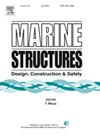Optimization design of helical carcass supported flexible cryogenic pipe based on BP-MOWOA
IF 5.1
2区 工程技术
Q1 ENGINEERING, CIVIL
引用次数: 0
Abstract
In recent years, the demand for offshore liquefied natural gas (LNG) exploration and transportation has set higher performance standards for cryogenic pipes, particularly the helical carcass supported flexible cryogenic pipe (hc-FCP). Due to its multi-layered, spiral-wound, and non-bonded structure, optimizing the design of hc-FCP presents significant challenges. This paper proposes an optimization approach combining the backpropagation neural network and the multi-objective whale optimization algorithm (BP-MOWOA) to address the multi-objective optimization of hc-FCP structures. First, a high-precision finite element model of the hc-FCP was established and validated through experimental data. The model was used to generate a large dataset that captured the mechanical performance of hc-FCP under various operating conditions. Second, a backpropagation (BP) neural network was trained to predict the axial tensile and bending stiffness of the hc-FCP, forming the basis for the optimization process. Lastly, the BP-MOWOA was employed to optimize critical design parameters, such as the winding angles of the reinforcement layers, to achieve maximum axial tensile stiffness and reduced bending stiffness with minimal material consumption. The optimized design improved axial tensile stiffness by 24.35 %, reduced bending stiffness by 2.99 %, and lowered material consumption by 1.84 %. These results demonstrate the effectiveness of the BP-MOWOA in optimizing hc-FCP structures for enhanced performance and cost-efficiency, providing a flexible solution for engineering applications in varying operational conditions.
基于BP-MOWOA的螺旋骨架支撑低温柔性管道优化设计
近年来,海上液化天然气(LNG)勘探和运输的需求对低温管道提出了更高的性能要求,特别是螺旋体支撑柔性低温管道(hc-FCP)。由于其多层、螺旋缠绕和非键合结构,hc-FCP的优化设计面临重大挑战。本文提出了一种结合反向传播神经网络和多目标鲸鱼优化算法(BP-MOWOA)的优化方法来解决hc-FCP结构的多目标优化问题。首先,建立了hc-FCP的高精度有限元模型,并通过实验数据进行了验证。该模型用于生成一个大型数据集,该数据集捕获了hc-FCP在各种操作条件下的力学性能。其次,训练反向传播(BP)神经网络预测hc-FCP的轴向拉伸和弯曲刚度,为优化过程奠定基础。最后,利用BP-MOWOA优化加固层缠绕角等关键设计参数,以最小的材料消耗获得最大的轴向拉伸刚度和降低的弯曲刚度。优化设计后,轴向拉伸刚度提高24.35%,弯曲刚度降低2.99%,材料消耗降低1.84%。这些结果证明了BP-MOWOA在优化hc-FCP结构方面的有效性,从而提高了性能和成本效益,为不同操作条件下的工程应用提供了灵活的解决方案。
本文章由计算机程序翻译,如有差异,请以英文原文为准。
求助全文
约1分钟内获得全文
求助全文
来源期刊

Marine Structures
工程技术-工程:海洋
CiteScore
8.70
自引率
7.70%
发文量
157
审稿时长
6.4 months
期刊介绍:
This journal aims to provide a medium for presentation and discussion of the latest developments in research, design, fabrication and in-service experience relating to marine structures, i.e., all structures of steel, concrete, light alloy or composite construction having an interface with the sea, including ships, fixed and mobile offshore platforms, submarine and submersibles, pipelines, subsea systems for shallow and deep ocean operations and coastal structures such as piers.
 求助内容:
求助内容: 应助结果提醒方式:
应助结果提醒方式:


